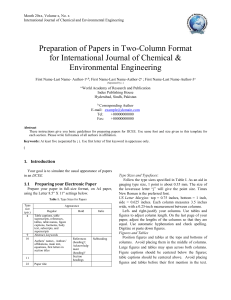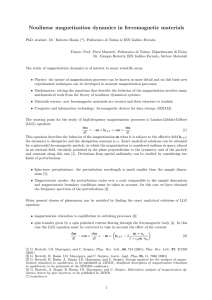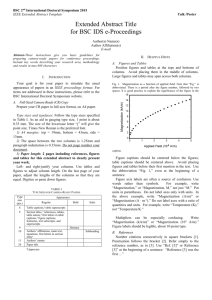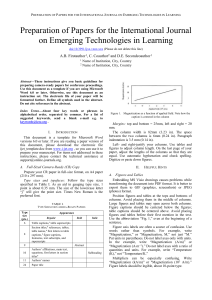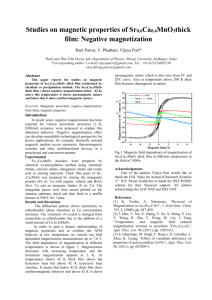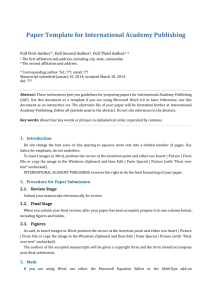BrukerTapes_Last - Indico
advertisement
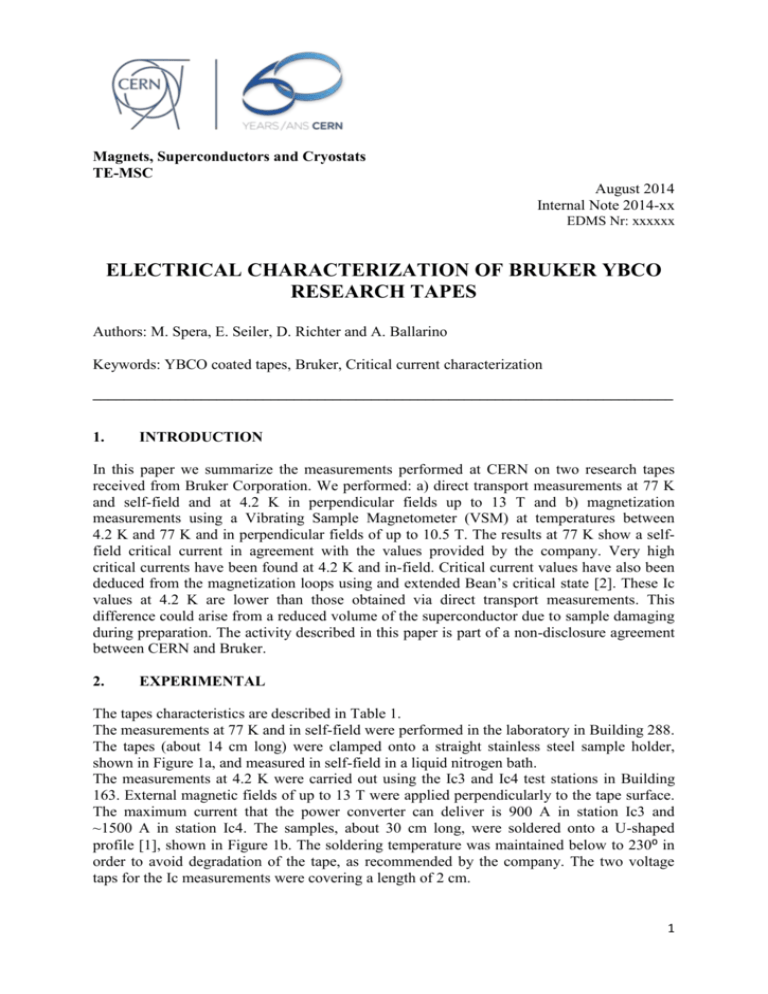
Magnets, Superconductors and Cryostats TE-MSC August 2014 Internal Note 2014-xx EDMS Nr: xxxxxx ELECTRICAL CHARACTERIZATION OF BRUKER YBCO RESEARCH TAPES Authors: M. Spera, E. Seiler, D. Richter and A. Ballarino Keywords: YBCO coated tapes, Bruker, Critical current characterization ___________________________________________________________________________ 1. INTRODUCTION In this paper we summarize the measurements performed at CERN on two research tapes received from Bruker Corporation. We performed: a) direct transport measurements at 77 K and self-field and at 4.2 K in perpendicular fields up to 13 T and b) magnetization measurements using a Vibrating Sample Magnetometer (VSM) at temperatures between 4.2 K and 77 K and in perpendicular fields of up to 10.5 T. The results at 77 K show a selffield critical current in agreement with the values provided by the company. Very high critical currents have been found at 4.2 K and in-field. Critical current values have also been deduced from the magnetization loops using and extended Bean’s critical state [2]. These Ic values at 4.2 K are lower than those obtained via direct transport measurements. This difference could arise from a reduced volume of the superconductor due to sample damaging during preparation. The activity described in this paper is part of a non-disclosure agreement between CERN and Bruker. 2. EXPERIMENTAL The tapes characteristics are described in Table 1. The measurements at 77 K and in self-field were performed in the laboratory in Building 288. The tapes (about 14 cm long) were clamped onto a straight stainless steel sample holder, shown in Figure 1a, and measured in self-field in a liquid nitrogen bath. The measurements at 4.2 K were carried out using the Ic3 and Ic4 test stations in Building 163. External magnetic fields of up to 13 T were applied perpendicularly to the tape surface. The maximum current that the power converter can deliver is 900 A in station Ic3 and ~1500 A in station Ic4. The samples, about 30 cm long, were soldered onto a U-shaped profile [1], shown in Figure 1b. The soldering temperature was maintained below to 230⁰ in order to avoid degradation of the tape, as recommended by the company. The two voltage taps for the Ic measurements were covering a length of 2 cm. 1 The magnetization measurements have been performed via a Vibrating Sample Magnetometer (VSM) at temperatures ranging from 4.2 K to 77 K and external applied fields up to 10.5 T. The samples have been cut in rectangular pieces and the field has been applied perpendicularly to the sample. Sample code Nominal Ic [A] T191D-C T190D-C 54 47 Nominal width [mm] 4.2 4.2 Substrate thickness [μm] 97 97 YBCO thickness [μm] 2 2 Table 1: Characteristics of the tapes as provide by the company b a Figure 1: (a) Straight sample holder for liquid nitrogen tests, (b) U-shaped sample holder for in-field measurements at 4.2 K 3. RESULTS Liquid nitrogen transport tests The results of the critical current measurements performed at 77 K are summarized in Table 1, where the values provided by Bruker (Nominal Ic) are also reported. Sample code Nominal Ic [A] Measured Ic [A] n-value T191D-C 54 54 21 T190D-C 47 52 23 Table 2: Critical currents and n-values measured for all the samples at 77 K and in self-field 2 Liquid helium transport tests Measurements have been carried out in magnetic fields from 5.5 T to 13 T applied perpendicularly (i.e. along the c direction) to the tape. Sample T191D-C and T190D-C were measured. The results obtained are presented in figure 2. 1400 T191D-C 1200 T190D-C 1000 Ic [A] 800 600 400 200 0 0 1 2 3 4 5 6 7 8 9 10 11 12 13 14 B [T] Figure 2: Critical current vs. B at 4.2 K The experimental points can all be fitted with a power decay of the kind: 𝐼𝑐 (𝐵) = 𝐼𝑐 (0) 𝐵 −𝜇 with 𝐼𝑐 (0) and 𝜇 free parameters. The fitting parameters for both tapes are summarized in Table 3. 3 Sample code Ic(0) [A] μ T191D-C 2958.5 0.722 T190D-C 3993.5 0.664 Table 3: Fitting parameters for the measured tapes As it can be seen from Table 3, the parameter μ is slightly different for the two tapes, as emerges from the different in-field behaviour. Magnetization measurements Magnetization measurements were carried out on sample T191D-C via a VSM in perpendicular applied fields and at various temperatures. The sample was rectangular with cross section of 4.4x5.4 mm2. The critical current values have been inferred using an extended Bean’s model formula [2]: 𝐼𝑐 (𝐵, 𝑇) = 𝑤𝑡 2 ∆𝑀(𝐵, 𝑇) 𝑤 𝑤 (1 − ) 3𝑙 where ∆𝑀 is the width of the magnetization loop, 𝑤 and 𝑙 are the sample’s dimensions, with 𝑤 ≤ 𝑙, and 𝑡 is the superconductor’s thickness. The derived values of the critical current at different temperatures and fields are summarized in Figure 3. 4 1400 4.2 K 10 K 1200 20 K 30 K 1000 40 K Ic [A] 50 K 800 60 K 600 400 200 0 0 2 4 B [T] 6 8 10 Figure 3: Ic vs. B results for sample T191D-C as derived from magnetization measurements CONCLUSIONS performed at different temperatures Figure 4 shows a comparison between the transport and the magnetization measurements at 4.2 K for sample T191D-C. Critical current values deduced from the magnetization loops are lower than the ones measured using the direct transport method. This difference could be due to a mechanical damage of the sample at the end during preparation/cutting for the VSM measurement- with consequent reduction the effective superconductor’s volume. 5 900 800 700 Ic [A] 600 500 Sample T191D-C 400 4.2 K 1500 300 Magnetization Ic [A] 200 1000 Transport 500 0 100 0 5 B [T] 10 15 0 0 2 4 6 B [T] 8 10 12 14 Figure 4: Difference in Ic between the transport and magnetization measurements for sample T191D-C at 4.2 K. Bottom left: Ic from magnetization measurements, as obtained after a reduction of the tape width of 0.9 mm, and direct transport measurements. If one considers the assumption concerning the damaging of the sample during its preparation, in order to have a correct matching of the curves (shown in the insert of figure 4), the length of the undamaged superconductor should be ~4.5 cm, which is to say, a reduction of 0.9 mm (~16 %) of the superconductor’s size. CONCLUSIONS We performed critical current tests on the samples received from Bruker Corporation via direct transport and magnetization measurements. The self-field critical currents at 77 K are ~50 A. The measurements at 4.2 K and in-field show very high critical current values, indicating a very well-engineered defect structure which promotes pinning. This also accounts for the low critical current value in self-field conditions, as in this case the defect structure is a limiting feature that suppresses the coherence of the order parameter. At 12 T the measured critical current is 491 A for sample T191D-C and 756 A for sample T190D-C. The magnetization measurements reproduce the same behaviour as the transport ones, with an uncertainty on the absolute value. 6 APPENDIX Measured magnetization loops on the sample T191D-C. 8 6 moment [emu] 4 4.2 K 2 10 K 20 K 0 30 K -2 50 K 60 K -4 40 K -6 -8 -4 -2 0 2 4 B [T] 6 8 10 12 REFERENCES [1] J. Fleiter, A. Ballarino, P. Chambouvet, L. Oberli, P-F. Jacquot, First Electrical characterization of YBCO film, TE-MSC-SCD Internal note, CERN, 2010 [2] D. -X. Chen, R. B. Goldfarb, Kim model for magnetization of type-II superconductors, J. Appl. Phys. 66, 6, 1989 7


![Photoinduced Magnetization in RbCo[Fe(CN)6]](http://s3.studylib.net/store/data/005886955_1-3379688f2eabadadc881fdb997e719b1-300x300.png)
